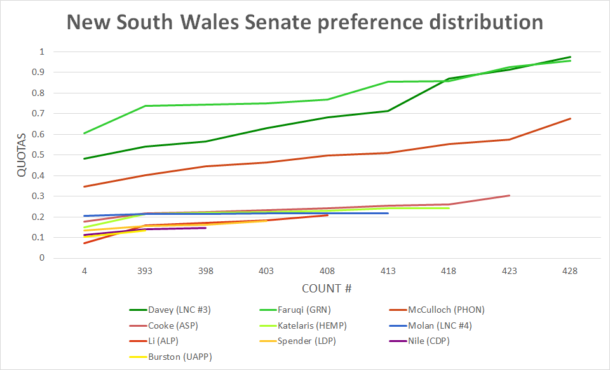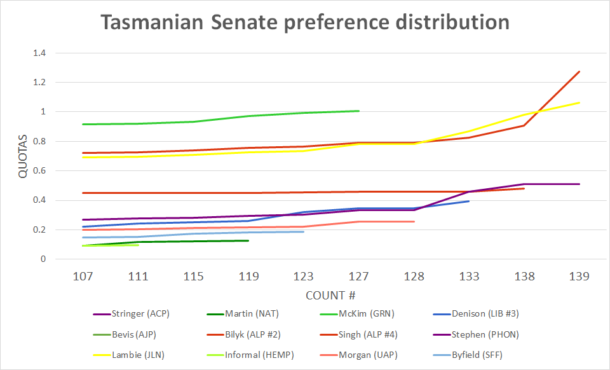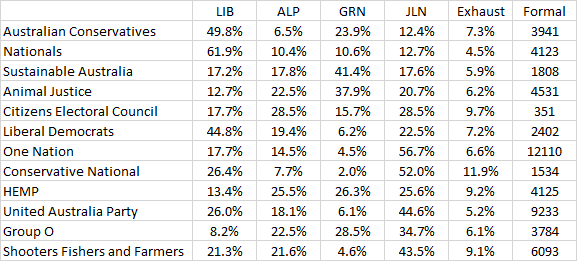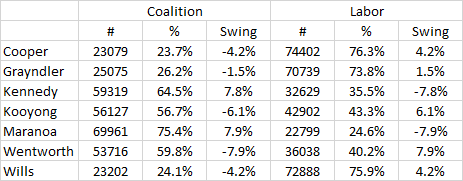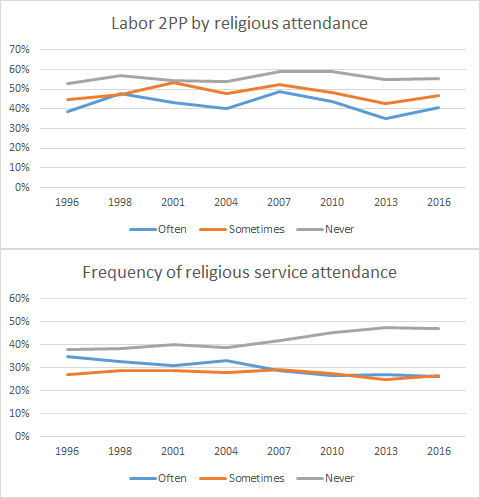A full display of the election results, with complete booth figures, swings and probability estimates, can be found here.
Monday, June 3
The four day break in counting in Macquarie ended with all one-way traffic for Labor: postals broke 154-125, out-of-division pre-polls 103-87 and absents 88-66, putting Labor’s lead out from 282 to 348. Antony Green has called it for Susan Templeman, and Templeman has claimed victory. A few hundred votes still to mop up, presumably tomorrow.
Friday, May 31
Still nothing from Macquarie.
Thursday, May 30
No counting was conducted in Macquarie today. I believe the few remaining scraps are likely to be tidied there today, with there not being enough there to overturn the 282 vote Labor lead. The only hope for the Liberals now is a serious error turning up in the full preference count.
Wednesday, May 29
Happily for Labor, my supposition that there wouldn’t be too many absents left in Macquarie was misplaced – a new batch today broke a handy 402-259 their way. The latest batch of out-of-division pre-polls also surprised in breaking 316-170 for Labor. This extends Labor’s lead from 67 to 282, and there wouldn’t be much more still out there than 500 or so pre-polls and 300 postals – unless I’m still wrong about absents, in which case Labor’s lead should widen further.
If any doubt remained in Cowan, it was dealt with by today’s 1456-1061 break to Labor on absents, along with 106-87 on the latest postals. This pushes the Labor lead from 825 to 1239, which means Labor’s lead here is actually greater than it is in Eden-Monaro and Lilley.
Tuesday, May 28
Labor finally took the lead in Macquarie today, emerging with a 67 vote lead after trailing by 39 votes yesterday. This was thanks to a stronger batch of absents than yesterday’s (505-438 to Labor), a slight gain on out-of-division pre-polls (483-477) and rechecking of ordinary votes, which cost the Liberals 27 votes and boosted Labor by six. However, there can’t be too many more absents left in the can, and the Liberals could hope to claw back about 40 votes on remaining postals, of which I would guess there are about 300. That leaves the result in the hands of maybe 1000 further out-of-division pre-polls. These have slightly favoured Labor so far, and did likewise in 2016, but batch results can vary considerably depending on where they are sourced from.
Macquarie is the only seat still seriously in doubt, as Labor’s Anne Aly stubbornly maintains her lead in Cowan. Today it went from 810 to 825, as a batch of out-of-division pre-polls favoured her 896-881. Their might be another 2000 absents and another 2000 out-of-division pre-polls to come, of which the former have favoured Labor while the latter have split exquisitely evenly. The Liberals would need at least a 55-45 split in their favour.
Monday, May 27
Macquarie remains close in every way, with today’s count dominated by a 493-471 split in favour of Labor on out-of-division pre-polls, and absents going 471-469 to Liberal. Together with rechecking, the net effect is to reduce the Liberal lead from 57 to 40. The result hinges mostly on perhaps 1800 outstanding absents, which can vary significantly in their behaviour from batch to batch. In Cowan, out-of-division pre-polls give the Liberals only a very slight boost, reducing the Labor lead from 833 to 810. The Liberals will need about 57% out of maybe 6000 outstanding votes, few of which are postals, the only vote type on which they have come close to doing that well.
Saturday, May 25
Only minor additions to the count today, but that’s enough to be significant in Macquarie, where the Liberal lead is now down from 71 to 46. A batch of declaration votes broke 108-73 in favour of Labor, offsetting a net Liberal gain of 10 from rechecking. Labor’s lead in Cowan is up from 813 to 833, mostly due to a batch of absents that broke 383-352. In Bass, out of division pre-polls broke 167-123 to Labor, reducing the Liberal lead from 699 to 656 (there were also tiny changes from rechecking). In Lilley, Labor’s lead went from 879 to 901 due to rechecking and out of division pre-polls, the latter of which broke 449-427 their way.
Friday, May 24
The small number of provisional votes were counted today in Cowan, and they behaved typically in giving Labor a slight boost, of 211-184. However, the advantage was outweighed by rechecking, with the Labor lead ending the day at 813, down from 839. But with only handfuls of postal voting yet to come, the Liberals are going to have to do unusually well on absents and out-of-division pre-polls.
Macquarie could very easily go either way, but only rechecking was conducted today, the effect of which was to reduce the Liberal lead from 131 to 71. Postals to continue to widen the Liberal lead in Bass, now out from 561 to 699, while absents have moved Labor further ahead in Lilley, from 817 to 879.
Thursday, May 23
Macquarie looks like going right down to the wire, with the first batch of absents favouring Labor 476-444, and the latest batch of postals reversing the earlier tide in breaking 259-194 to Labor. That cuts yesterday’s Liberal lead of 196 to 131. In Cowan, Labor’s lead is out from 748 to 839 as the first absents break 941-843 their way. Conversely, the first absents from Bass have broken 836-787 to Liberal, which, together with rechecking, pushes the Liberal lead out from 497 to 561. In Lilley, Labor’s lead slips slightly from 842 to 817 as the latest postals break 875-787 to the LNP, outweighing a rather hefty 275-197 Labor advantage on the first absents.
Wednesday, May 22
Only rechecking today in Cowan, where Labor ended the day 748 ahead, compared with 762 yesterday. Elsewhere:
Chisholm. Another batch of postals breaks 1064-905 to the Liberal, increasing their lead from 1220 to 1379.
Macquarie. The latest postals have broken 524-396 to Liberal, exactly the same proportion as those already in the count, increasing their lead from 68 to 196.
Bass. The Liberal lead nudges from 453 to 497, with the latest postals breaking 517-483 to Liberal together with some slight ordinary vote adjustments on rechecking.
Lilley. A big batch of postals breaks very much like the first, going to 2551-2093 to the LNP, which reduces the Labor lead from 1288 to 842, but doesn’t change the impression that Labor should be able to hold on.
Tuesday, May 21
My election results facility, linked to above, has ended the day less buggily than it began. Developments from today’s count:
Chisholm. Another 3963 postals have gone similarly the first 5413, and in doing so have increased the Liberal lead from 591 to 1220. The trend of absent votes in 2016 suggests Labor should only be able to claw back about 250 there.
Macquarie. Only rechecking done today, nudging the Liberal lead from 50 to 68. Labor should only make slight gains on absent and out-of-division pre-polls, which I think more likely than not to be outweighed by the Liberal gain on outstanding postals.
Bass. I thought the first batch of postals surprisingly strong for Labor, but it turns out postals behaved no differently from ordinary votes in 2016 as well, where usually they lean conservative. Today’s batch, however, went 767-706 in favour of the Liberals, increasing the lead from 392 to 453. Absent votes were likewise bang on the ordinary votes in 2016; out-of-division pre-polls favoured Liberal. So Labor would need to pull a rabbit out of the hat here.
Lilley. A rare bit of good news for Labor, in that it looks an error had been made in the Geebung booth that had it favouring the LNP 1046-830, but which has now shows as 1033-862 in favour of Labor. That boosts their lead from 901 to 1288, which you’d think would be enough.
Cowan. Labor’s lead has reduced from 1006 to 762 on the back of a second batch of postals, which went 1223-1040 to the Liberals – slightly less favourable for them than the first, of which the Liberals got 56.9% rather than 54.0% – and ordinary vote rechecking, which boosted them by 61. However, absents and out-of-division pre-polls in 2016 behaved very much like ordinary votes, and there shouldn’t be a huge mass of postals outstanding, so I would think it likely Labor will hang on.
Monday, May 20
As you can see above, I now have an election results facility in business, albeit still with a few bugs to be ironed out. With that more-or-less accomplished, I should be able to follow the final stages of the count in more detail. It now appears clear that the Coalition has secured a majority, the most likely result being 77 seats out of 151. Counting of postal votes is still at a fairly advanced stage, and these reliably lean conservative, so the trend of yesterday’s counting was in their favour. However, no absent votes have been counted, and these can sometimes go the other way. Furthermore, Kevin Bonham believes he has observed a tendency of the first batches of postals to be more conservative than later ones. With that in mind, here’s the latest mail from those undecided seats where counting progressed yesterday, i.e. all of them other than Indi and Boothby, where I’m probably being overly cautious in not calling them for independent and Liberal respectively.
Chisholm. Liberal candidate Gladys Liu extended her lead yesterday from 166 to 591. Postals have so far recorded a smaller swing to Labor, of 0.8%, than ordinary votes, which swung 2.5%. Still in doubt.
Macquarie. The Liberals now lead here by 50 votes, after trailing by 312 yesterday. Postals have so far recorded a 2.2% swing to the Liberals, not much different from ordinary votes. Still in doubt.
Bass. Better news for Labor here, with the Liberal lead narrowing from 437 to 392, and postals surprisingly swinging slightly in Labor’s favour after ordinary votes swung over 6%. Still in doubt.
Lilley. Labor’s lead narrowed yesterday from 1110 to 901. Postals haven’t swung much differently from ordinary votes so far, so Labor seem likely to hold on.
Wentworth. Kerryn Phelps conceded defeat to Liberal candidate Dave Sharma yesterday as a strong trend on postals blew the lead out from 1751 to 2864.
Sunday, May 19
This post will be used to provide regularly updated coverage of late counting in seats that remain in doubt, of which I count seven: the marginal Liberal seat of Chisholm in Melbourne, where newcomer Gladys Liu leads by 166 votes (0.11%); Macquarie on Sydney’s western fringe, where Labor incumbent Susan Templeman is 312 votes in front (0.18%); Bass, where Liberal candidate Bridget Archer holds a lead of 437 votes (0.36%) over Labor incumbent Ross Hart; Indi, where independent candidate Helen Haines holds a 2781 lead (1.6%) over the Liberals in her bid to succeed retiring independent Cathy McGowan; Labor-held Lilley in Brisbane, where Labor’s Anika Wells hold a 1110 vote lead (0.69%) as she seeks to succeed the retiring Wayne Swan; and, stretching it a little further, Wentworth, where Liberal candidate Dave Sharma now holds a 1751 lead (1.16%) over independent incumbent Kerryn Phelps, and Boothby, where Liberal incumbent Nicolle Flint leads Labor by 2183 votes (1.18%). Hopefully tomorrow I will finally get the time to fix the bugs in a results reporting facility that will report results and swings at booth level.
